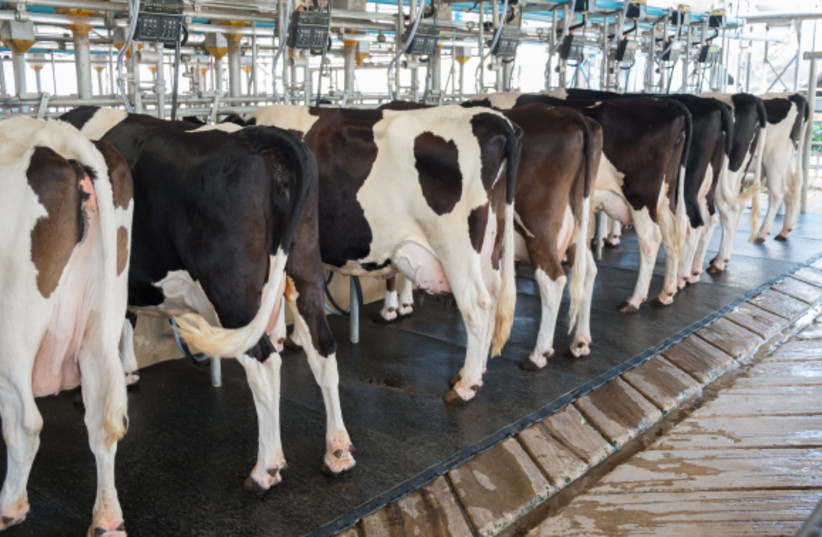Nearly 500 million people around the world suffer from type-2 diabetes, caused mostly by poor diet, obesity, and lack of physical activity, and an estimated 200 million of them are dependent on insulin therapy for their health.
In addition, there are about nine million people with type-1 diabetes because their pancreas doesn’t produce any insulin because the body’s immune system attacks the islet cells in the pancreas.
The worldwide growing demand for human insulin, which is growing by leaps and bounds, costs their health insurers hundreds of billions, and in poor countries, some patients don’t get the drug they need.
The first cow to be able to produce insulin in her milk
Now, an unassuming brown bovine from the south of Brazil has made history as the first transgenic cow capable of producing human insulin in her milk. The advancement, led by researchers from the University of Illinois Urbana-Champaign and the Universidade de São Paulo, could herald a new era in insulin production, eventually eliminating drug scarcity and high costs for people living with diabetes.
“Mother Nature designed the mammary gland as a factory to make protein really, really efficiently. We can take advantage of that system to produce a protein that can help hundreds of millions of people worldwide,” said animal sciences professor Matt Wheeler at Illinois University.

Wheeler is the lead author of a new Biotechnology Journal study entitled “Human proinsulin production in the milk of transgenic cattle,” which described the development of the insulin-producing cow, a proof-of-concept achievement that could be scaled up after additional testing and US Food and Drug Administration (FDA) approval.
Wheeler’s colleagues in Brazil inserted a segment of human DNA coding for proinsulin – the protein precursor of the active form of insulin – into the cell nuclei of 10 cow embryos. These were implanted in the uteruses of normal cows in Brazil, and one transgenic calf was born. Thanks to updated genetic engineering technology, human DNA was targeted for expression – the process whereby gene sequences are read and translated into protein products – in mammary tissue only.
“In the old days, we used to just push DNA in and hope it got expressed where you wanted it to,” Wheeler recalled. “We can be much more strategic and targeted these days. Using a DNA construct specific to mammary tissue means there’s no human insulin circulating in the cow’s blood or other tissues. It also takes advantage of the mammary gland’s capabilities for producing large quantities of protein.”
When the cow reached maturity, the team unsuccessfully attempted to impregnate her using standard artificial insemination techniques. Instead, they stimulated her first lactation using hormones. The lactation yielded milk, but a smaller quantity than would occur after a successful pregnancy. Still, human proinsulin and, surprisingly, insulin were detectable in the milk.
“Our goal was to make proinsulin, purify it to insulin, and go from there. But the cow basically processed it herself. She makes about three-to-one biologically active insulin to proinsulin,” Wheeler said. “The mammary gland is a magical thing.”
The insulin and proinsulin that would need to be extracted and purified for use were expressed at a few grams per liter in the milk – but because the lactation was induced hormonally and the milk volume was smaller than expected, the team can’t say exactly how much insulin would be made in a typical lactation.
Conservatively, Wheeler says if a cow could make one gram of insulin per liter and a typical Holstein yields 40 to 50 liters per day, that’s a lot of insulin. Especially since the typical unit of insulin equals 0.0347 milligrams.
“That means each gram is equivalent to 28,818 units of insulin,” Wheeler said. “And that's just one liter; Holsteins can produce 50 liters daily. You can do the math.”
The team members plan to re-clone the cow, and they are optimistic they’ll achieve greater success with pregnancy and full lactation cycles in the next generation. Eventually, they hope to create transgenic bulls to mate with the females, creating transgenic offspring that can be used to establish a purpose-built herd. Wheeler says even a small herd could quickly outcompete existing methods – transgenic yeast and bacteria – for producing insulin and could do so without having to create highly technical facilities or infrastructure.
“With regard to mass-producing insulin in milk, you’d need specialized, high-health-status facilities for the cattle, but it wouldn’t be very hard for our well-established dairy industry,” Wheeler said. “We know what we’re doing with cows.”
Before transgenic cows could supply insulin for the world's diabetics, an efficient system to collect and purify insulin products and FDA approval would be needed, but Wheeler is confident that day is coming.
“I could see a future where a 100-head herd, equivalent to a small Illinois or Wisconsin dairy, could produce all the insulin needed for the country,” he said. “And a larger herd? You could make the whole world’s supply in a year.
